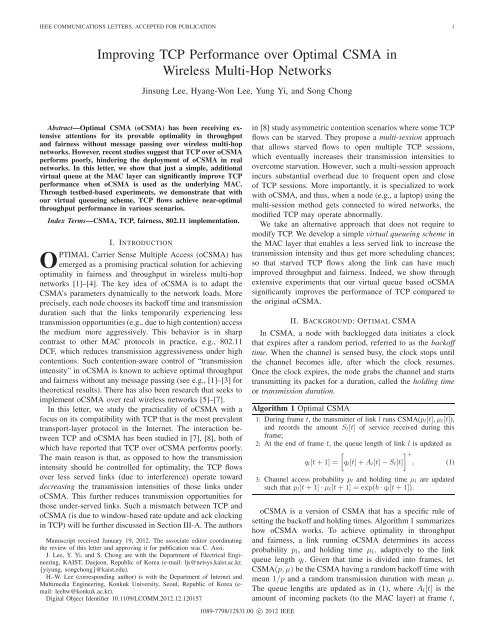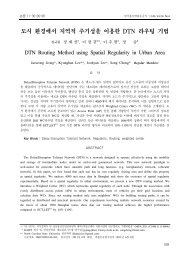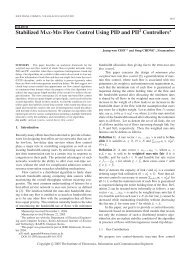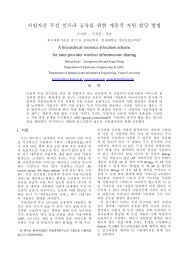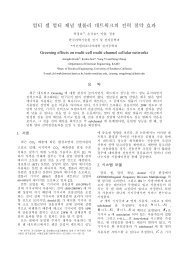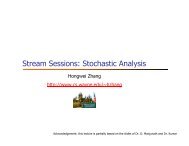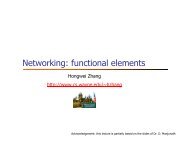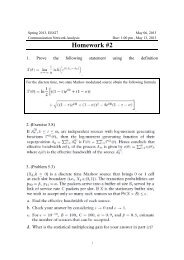Improving TCP Performance over Optimal CSMA in Wireless ... - KAIST
Improving TCP Performance over Optimal CSMA in Wireless ... - KAIST
Improving TCP Performance over Optimal CSMA in Wireless ... - KAIST
Create successful ePaper yourself
Turn your PDF publications into a flip-book with our unique Google optimized e-Paper software.
IEEE COMMUNICATIONS LETTERS, ACCEPTED FOR PUBLICATION 1<br />
<strong>Improv<strong>in</strong>g</strong> <strong>TCP</strong> <strong>Performance</strong> <strong>over</strong> <strong>Optimal</strong> <strong>CSMA</strong> <strong>in</strong><br />
<strong>Wireless</strong> Multi-Hop Networks<br />
Abstract—<strong>Optimal</strong> <strong>CSMA</strong> (o<strong>CSMA</strong>) has been receiv<strong>in</strong>g extensive<br />
attentions for its provable optimality <strong>in</strong> throughput<br />
and fairness without message pass<strong>in</strong>g <strong>over</strong> wireless multi-hop<br />
networks. However, recent studies suggest that <strong>TCP</strong> <strong>over</strong> o<strong>CSMA</strong><br />
performs poorly, h<strong>in</strong>der<strong>in</strong>g the deployment of o<strong>CSMA</strong> <strong>in</strong> real<br />
networks. In this letter, we show that just a simple, additional<br />
virtual queue at the MAC layer can significantly improve <strong>TCP</strong><br />
performance when o<strong>CSMA</strong> is used as the underly<strong>in</strong>g MAC.<br />
Through testbed-based experiments, we demonstrate that with<br />
our virtual queue<strong>in</strong>g scheme, <strong>TCP</strong> flows achieve near-optimal<br />
throughput performance <strong>in</strong> various scenarios.<br />
Index Terms—<strong>CSMA</strong>, <strong>TCP</strong>, fairness, 802.11 implementation.<br />
I. INTRODUCTION<br />
OPTIMAL Carrier Sense Multiple Access (o<strong>CSMA</strong>) has<br />
emerged as a promis<strong>in</strong>g practical solution for achiev<strong>in</strong>g<br />
optimality <strong>in</strong> fairness and throughput <strong>in</strong> wireless multi-hop<br />
networks [1]–[4]. The key idea of o<strong>CSMA</strong> is to adapt the<br />
<strong>CSMA</strong>’s parameters dynamically to the network loads. More<br />
precisely, each node chooses its backoff time and transmission<br />
duration such that the l<strong>in</strong>ks temporarily experienc<strong>in</strong>g less<br />
transmission opportunities (e.g., due to high contention) access<br />
the medium more aggressively. This behavior is <strong>in</strong> sharp<br />
contrast to other MAC protocols <strong>in</strong> practice, e.g., 802.11<br />
DCF, which reduces transmission aggressiveness under high<br />
contentions. Such contention-aware control of “transmission<br />
<strong>in</strong>tensity” <strong>in</strong> o<strong>CSMA</strong> is known to achieve optimal throughput<br />
and fairness without any message pass<strong>in</strong>g (see e.g., [1]–[3] for<br />
theoretical results). There has also been research that seeks to<br />
implement o<strong>CSMA</strong> <strong>over</strong> real wireless networks [5]–[7].<br />
In this letter, we study the practicality of o<strong>CSMA</strong> with a<br />
focus on its compatibility with <strong>TCP</strong> that is the most prevalent<br />
transport-layer protocol <strong>in</strong> the Internet. The <strong>in</strong>teraction between<br />
<strong>TCP</strong> and o<strong>CSMA</strong> has been studied <strong>in</strong> [7], [8], both of<br />
which have reported that <strong>TCP</strong> <strong>over</strong> o<strong>CSMA</strong> performs poorly.<br />
The ma<strong>in</strong> reason is that, as opposed to how the transmission<br />
<strong>in</strong>tensity should be controlled for optimality, the <strong>TCP</strong> flows<br />
<strong>over</strong> less served l<strong>in</strong>ks (due to <strong>in</strong>terference) operate toward<br />
decreas<strong>in</strong>g the transmission <strong>in</strong>tensities of those l<strong>in</strong>ks under<br />
o<strong>CSMA</strong>. This further reduces transmission opportunities for<br />
those under-served l<strong>in</strong>ks. Such a mismatch between <strong>TCP</strong> and<br />
o<strong>CSMA</strong> (is due to w<strong>in</strong>dow-based rate update and ack clock<strong>in</strong>g<br />
<strong>in</strong> <strong>TCP</strong>) will be further discussed <strong>in</strong> Section III-A. The authors<br />
Manuscript received January 19, 2012. The associate editor coord<strong>in</strong>at<strong>in</strong>g<br />
the review of this letter and approv<strong>in</strong>g it for publication was C. Assi.<br />
J. Lee, Y. Yi, and S. Chong are with the Department of Electrical Eng<strong>in</strong>eer<strong>in</strong>g,<br />
<strong>KAIST</strong>, Daejeon, Republic of Korea (e-mail: ljs@netsys.kaist.ac.kr,<br />
{yiyung, songchong}@kaist.edu).<br />
H.-W. Lee (correspond<strong>in</strong>g author) is with the Department of Internet and<br />
Multimedia Eng<strong>in</strong>eer<strong>in</strong>g, Konkuk University, Seoul, Republic of Korea (email:<br />
leehw@konkuk.ac.kr).<br />
Digital Object Identifier 10.1109/LCOMM.2012.12.120157<br />
J<strong>in</strong>sung Lee, Hyang-Won Lee, Yung Yi, and Song Chong<br />
1089-7798/12$31.00 c○ 2012 IEEE<br />
<strong>in</strong> [8] study asymmetric contention scenarios where some <strong>TCP</strong><br />
flows can be starved. They propose a multi-session approach<br />
that allows starved flows to open multiple <strong>TCP</strong> sessions,<br />
which eventually <strong>in</strong>creases their transmission <strong>in</strong>tensities to<br />
<strong>over</strong>come starvation. However, such a multi-session approach<br />
<strong>in</strong>curs substantial <strong>over</strong>head due to frequent open and close<br />
of <strong>TCP</strong> sessions. More importantly, it is specialized to work<br />
with o<strong>CSMA</strong>, and thus, when a node (e.g., a laptop) us<strong>in</strong>g the<br />
multi-session method gets connected to wired networks, the<br />
modified <strong>TCP</strong> may operate abnormally.<br />
We take an alternative approach that does not require to<br />
modify <strong>TCP</strong>. We develop a simple virtual queue<strong>in</strong>g scheme <strong>in</strong><br />
the MAC layer that enables a less served l<strong>in</strong>k to <strong>in</strong>crease the<br />
transmission <strong>in</strong>tensity and thus get more schedul<strong>in</strong>g chances;<br />
so that starved <strong>TCP</strong> flows along the l<strong>in</strong>k can have much<br />
improved throughput and fairness. Indeed, we show through<br />
extensive experiments that our virtual queue based o<strong>CSMA</strong><br />
significantly improves the performance of <strong>TCP</strong> compared to<br />
the orig<strong>in</strong>al o<strong>CSMA</strong>.<br />
II. BACKGROUND: OPTIMAL <strong>CSMA</strong><br />
In <strong>CSMA</strong>, a node with backlogged data <strong>in</strong>itiates a clock<br />
that expires after a random period, referred to as the backoff<br />
time. When the channel is sensed busy, the clock stops until<br />
the channel becomes idle, after which the clock resumes.<br />
Once the clock expires, the node grabs the channel and starts<br />
transmitt<strong>in</strong>g its packet for a duration, called the hold<strong>in</strong>g time<br />
or transmission duration.<br />
Algorithm 1 <strong>Optimal</strong> <strong>CSMA</strong><br />
1: Dur<strong>in</strong>g frame t, the transmitter of l<strong>in</strong>k l runs <strong>CSMA</strong>(pl[t],µl[t]),<br />
and records the amount Sl[t] of service received dur<strong>in</strong>g this<br />
frame;<br />
2: At the end of frame t, the queue length of l<strong>in</strong>k l is updated as<br />
<br />
+<br />
ql[t +1]= ql[t]+Al[t] − Sl[t] , (1)<br />
3: Channel access probability pl and hold<strong>in</strong>g time µl are updated<br />
such that pl[t +1]· µl[t +1]=exp(b · ql[t +1]).<br />
o<strong>CSMA</strong> is a version of <strong>CSMA</strong> that has a specific rule of<br />
sett<strong>in</strong>g the backoff and hold<strong>in</strong>g times. Algorithm 1 summarizes<br />
how o<strong>CSMA</strong> works. To achieve optimality <strong>in</strong> throughput<br />
and fairness, a l<strong>in</strong>k runn<strong>in</strong>g o<strong>CSMA</strong> determ<strong>in</strong>es its access<br />
probability pl, and hold<strong>in</strong>g time µl, adaptively to the l<strong>in</strong>k<br />
queue length ql. Given that time is divided <strong>in</strong>to frames, let<br />
<strong>CSMA</strong>(p, µ) be the <strong>CSMA</strong> hav<strong>in</strong>g a random backoff time with<br />
mean 1/p and a random transmission duration with mean µ.<br />
The queue lengths are updated as <strong>in</strong> (1), where Al[t] is the<br />
amount of <strong>in</strong>com<strong>in</strong>g packets (to the MAC layer) at frame t,
2 IEEE COMMUNICATIONS LETTERS, ACCEPTED FOR PUBLICATION<br />
and Sl[t] is the amount of served packets at frame t <strong>over</strong> l<strong>in</strong>k l,<br />
and [·] + ≡ max(·, 0). We def<strong>in</strong>e the transmission <strong>in</strong>tensity of<br />
l<strong>in</strong>k l as the product of pl and µl, and hence, it represents<br />
the aggressiveness of l<strong>in</strong>k l’s transmission attempts. As <strong>in</strong><br />
Step 3 of Algorithm 1, the transmission <strong>in</strong>tensity is equal to<br />
exp(b·ql), wherebis a positive scal<strong>in</strong>g parameter that prevents<br />
the exponential function from grow<strong>in</strong>g too large. Therefore,<br />
for a given µ, the access probability pl is an exponential<br />
function of the queue length of l<strong>in</strong>k l, and this makes a l<strong>in</strong>k<br />
with larger backlog attempt to transmit more aggressively.<br />
This property has an important implication to the upper-layer<br />
congestion control as discussed <strong>in</strong> the follow<strong>in</strong>g.<br />
The amount of <strong>in</strong>com<strong>in</strong>g packets <strong>over</strong> each l<strong>in</strong>k l, Al[t]<br />
is determ<strong>in</strong>ed by the source rate (or congestion) control<br />
algorithm. It was shown <strong>in</strong> [1], [2] that when a utility based<br />
congestion control (UBC) is used, the optimal throughput is<br />
guaranteed <strong>in</strong> the sense that the long-term rate x⋆ =(x⋆ l :<br />
l ∈ L) (L is the set of all l<strong>in</strong>ks) is the solution of the<br />
follow<strong>in</strong>g optimization problem: x⋆ <br />
=argmaxxlU(xl).<br />
Of particular <strong>in</strong>terest is log utility function, i.e., U(·) = log(·),<br />
<strong>in</strong> which case the UBC source rate control is given as<br />
Al[t] =V/ql[t] for some positive constant V . This source rate<br />
control together with o<strong>CSMA</strong> achieves proportional fairness<br />
[5], [7]. Intuitively, the MAC-layer queues of less served l<strong>in</strong>ks<br />
will build up due to the arrival, and thus, their transmission<br />
<strong>in</strong>tensities will <strong>in</strong>crease to obta<strong>in</strong> more transmission opportunities.<br />
On the other hand, the source <strong>in</strong>jection rate decreases<br />
as the queue length <strong>in</strong>creases, so that less served l<strong>in</strong>ks do<br />
not attempt transmission too aggressively. This prevents heavy<br />
contention and has the effect of balanc<strong>in</strong>g throughput among<br />
compet<strong>in</strong>g flows.<br />
III. VIRTUAL QUEUE BASED O<strong>CSMA</strong><br />
A. Why <strong>TCP</strong> <strong>over</strong> o<strong>CSMA</strong> performs poorly?<br />
The ma<strong>in</strong> reason for <strong>TCP</strong>’s poor performance is that with<br />
<strong>TCP</strong>, even a l<strong>in</strong>k experienc<strong>in</strong>g few schedul<strong>in</strong>g chances would<br />
not be able to <strong>in</strong>crease its queue length, which keeps the<br />
starved l<strong>in</strong>ks to stay starved. This is ma<strong>in</strong>ly due to the<br />
w<strong>in</strong>dow-based congestion control <strong>in</strong> <strong>TCP</strong>, which generates<br />
packets based on ack clock<strong>in</strong>g. We briefly summarize the<br />
ack-clock<strong>in</strong>g mechanism of <strong>TCP</strong>. A <strong>TCP</strong> sender ma<strong>in</strong>ta<strong>in</strong>s a<br />
congestion w<strong>in</strong>dow (CWND), which is the maximum amount<br />
of packets that can be transmitted without acknowledgement<br />
(ACK) packets from the correspond<strong>in</strong>g receiver. The CWND<br />
value is <strong>in</strong>creased when the transmitted packets have been<br />
acknowledged by the receiver with<strong>in</strong> a certa<strong>in</strong> time, and decreased<br />
otherwise. This w<strong>in</strong>dow-based rate control can result<br />
<strong>in</strong> the starvation of <strong>TCP</strong> flows under o<strong>CSMA</strong> that assigns<br />
schedul<strong>in</strong>g priority to heavily backlogged l<strong>in</strong>ks.<br />
Consider a <strong>TCP</strong> flow travers<strong>in</strong>g a l<strong>in</strong>k, say l. Assume that<br />
l<strong>in</strong>k l is less scheduled than other l<strong>in</strong>ks due to such as heavier<br />
<strong>in</strong>terference. The <strong>TCP</strong> flows along the well-served l<strong>in</strong>ks easily<br />
<strong>in</strong>crease their CWNDs, whereas the <strong>TCP</strong> flow along l<strong>in</strong>k l<br />
has difficulty <strong>in</strong> do<strong>in</strong>g so s<strong>in</strong>ce its packets rarely reach to<br />
the dest<strong>in</strong>ation. Note that the number of packets that can<br />
be enqueued <strong>in</strong>to the MAC buffer is limited by the CWND<br />
value. Thus, under o<strong>CSMA</strong>, l<strong>in</strong>k l is likely to have lower<br />
transmission <strong>in</strong>tensity than other l<strong>in</strong>ks, and consequently,<br />
0 2<br />
1 3<br />
(a) FIM<br />
4<br />
5<br />
0 1 2<br />
2-hop flow<br />
1-hop flow<br />
(b) Multihop<br />
1 2<br />
4 3<br />
(c) <strong>TCP</strong>+UBC<br />
Fig. 1. Problematic scenarios; gray (resp., black) vertices represent nodes<br />
(resp., l<strong>in</strong>ks), dotted l<strong>in</strong>es represent connectivity (resp., <strong>in</strong>terference), and<br />
arrows represent flows; a) FIM: only the middle l<strong>in</strong>k (2, 3) <strong>in</strong>terferes with<br />
two outer l<strong>in</strong>ks (0, 1) and (4, 5); b) Multi-hop: there exist a 2-hop and a 1hop<br />
flows <strong>in</strong> the fully connected network; c) <strong>TCP</strong>+UBC (contention graph):<br />
all l<strong>in</strong>ks <strong>in</strong>terfere with each other; l<strong>in</strong>ks 1, 2, and 3 have UBC flows and l<strong>in</strong>k<br />
4hasa<strong>TCP</strong>flow.<br />
l<strong>in</strong>k l will receive fewer transmission opportunities. This can<br />
repeatedly occur, severely throttl<strong>in</strong>g the <strong>TCP</strong> flow <strong>over</strong> l<strong>in</strong>k<br />
l. This mismatch between <strong>TCP</strong> and o<strong>CSMA</strong> can be more<br />
visibly expla<strong>in</strong>ed <strong>in</strong> the example network topologies appear<strong>in</strong>g<br />
<strong>in</strong> many practical scenarios (see Fig. 1).<br />
Flow-<strong>in</strong>-the-middle (FIM). The topology <strong>in</strong> Fig. 1(a) is a<br />
well-known asymmetric contention scenario, where the middle<br />
l<strong>in</strong>k may often defer its transmission s<strong>in</strong>ce it can transmit only<br />
when both of outer l<strong>in</strong>ks are idle. In this case, the <strong>in</strong>ner l<strong>in</strong>k is<br />
scheduled much less than the others, and as discussed above,<br />
the <strong>TCP</strong> flow along the <strong>in</strong>ner l<strong>in</strong>k will struggle to <strong>in</strong>crease<br />
its CWND. This leads to the starvation of <strong>TCP</strong> flow <strong>over</strong> the<br />
middle l<strong>in</strong>k when the underly<strong>in</strong>g MAC adopts o<strong>CSMA</strong>.<br />
Heterogeneous hops. In o<strong>CSMA</strong>, the l<strong>in</strong>ks along the path of a<br />
multi-hop flow may have lower transmission <strong>in</strong>tensities, s<strong>in</strong>ce<br />
the number of packets on the path is constra<strong>in</strong>ed by the <strong>TCP</strong>’s<br />
CWND and the packets are spread <strong>over</strong> the l<strong>in</strong>ks (see Fig.<br />
1(b)). Consequently, with o<strong>CSMA</strong>, the l<strong>in</strong>ks along the path of<br />
a multi-hop <strong>TCP</strong> flow are scheduled sporadically compared to<br />
that of a s<strong>in</strong>gle-hop <strong>TCP</strong> flow, and thus, multi-hop <strong>TCP</strong> flows<br />
yield extremely low throughput.<br />
Heterogenous protocol. Consider a scenario where <strong>TCP</strong> flows<br />
coexist with non-<strong>TCP</strong> flows that work well with o<strong>CSMA</strong> such<br />
as UBC flows (see Fig. 1(c)). As discussed above, when there<br />
is heavy contention, the <strong>TCP</strong> flow rarely <strong>in</strong>creases its CWND,<br />
lead<strong>in</strong>g to small backlog <strong>in</strong> the MAC buffer. On the other<br />
hand, the UBC sources keep <strong>in</strong>ject<strong>in</strong>g their packets (although<br />
the <strong>in</strong>jection rate decreases as the queue builds up), lead<strong>in</strong>g to<br />
large backlog. Therefore, the UBC flows will be served better<br />
than the <strong>TCP</strong> flow and eventually, UBC flows will dom<strong>in</strong>ate<br />
<strong>TCP</strong> flows.<br />
B. Virtual Queue based o<strong>CSMA</strong><br />
Mechanism. To improve <strong>TCP</strong> performance <strong>over</strong> o<strong>CSMA</strong>,<br />
we develop a mechanism that ensures that whenever a l<strong>in</strong>k<br />
traversed by a <strong>TCP</strong> flow is scheduled less than the others, its<br />
transmission <strong>in</strong>tensity should be appropriately <strong>in</strong>creased; so<br />
that the <strong>TCP</strong> flow escapes from the starvation loop discussed<br />
<strong>in</strong> Section III-A. Note that the poor <strong>TCP</strong> performance results<br />
from the coupl<strong>in</strong>g between the MAC-layer queue and <strong>TCP</strong>.<br />
Hence, our idea is to decouple the actual MAC queue and <strong>TCP</strong><br />
dynamics. In particular, we <strong>in</strong>troduce an additional counter,<br />
called virtual queue and use the virtual queue length to<br />
determ<strong>in</strong>e the parameters of o<strong>CSMA</strong>.
LEE et al.: IMPROVING <strong>TCP</strong> PERFORMANCE OVER OPTIMAL <strong>CSMA</strong> IN WIRELESS MULTI-HOP NETWORKS 3<br />
o<strong>CSMA</strong><br />
<strong>TCP</strong> DATA<br />
A l[t]<br />
Actual<br />
Queue Virtual<br />
Queue VQ-<br />
o<strong>CSMA</strong><br />
S l[t] S l[t]<br />
Fig. 2. Implementation of VQ-o<strong>CSMA</strong> algorithm; <strong>TCP</strong> packet triggers the<br />
update of virtual queue (vql) whose arrival process is Al[t] (= V/vql[t]) and<br />
departure process is the amount of scheduled packets, Sl[t], at frame t.<br />
In the MAC layer, each l<strong>in</strong>k l ma<strong>in</strong>ta<strong>in</strong>s a virtual queue vql<br />
updated as follows:<br />
<br />
vql[t +1]= vql[t]+ V<br />
∞ − Sl[t] (2)<br />
vql[t] vq<br />
where [·] c d ≡ max(d, m<strong>in</strong>(c, ·)). The update of vql is similar<br />
to that of ql <strong>in</strong> (1) except that the arrivals to vql are virtually<br />
generated accord<strong>in</strong>g to V/vql[t] (where V is a positive<br />
control parameter). Thus, the arrival rate decreases when the<br />
virtual queue builds up, and <strong>in</strong>creases when the virtual queue<br />
decreases. Each l<strong>in</strong>k chooses the transmission <strong>in</strong>tensity us<strong>in</strong>g<br />
the virtual queue length <strong>in</strong>stead of the actual backlog, i.e.,<br />
pl[t +1]· µl[t +1] = exp(b · vql[t +1]). As a result, even<br />
when a l<strong>in</strong>k that a starved <strong>TCP</strong> flow traverses has small<br />
backlog, its virtual queue builds up and thus the transmission<br />
<strong>in</strong>tensity <strong>in</strong>creases. This will provide more schedul<strong>in</strong>g chances<br />
to the l<strong>in</strong>k, improv<strong>in</strong>g the starved <strong>TCP</strong> flow’s throughput. The<br />
parameter vq lower-bounds the virtual queue length to prevent<br />
a pathological case that when vql is (close to) zero, the arrival<br />
V/vql grows to <strong>in</strong>f<strong>in</strong>ity. For convenience, <strong>in</strong> the experiment,<br />
we use vq =1, which <strong>in</strong>dicates that there exists at least a<br />
s<strong>in</strong>gle virtual packet <strong>in</strong> the virtual queue.<br />
Implementation. Our mechanism requires only a slight modification<br />
of add<strong>in</strong>g a counter operation for the virtual queue<br />
update at MAC layer, thus it is easy to implement on real hardware<br />
at a negligible cost. Fig. 2 describes the implementation<br />
of VQ-o<strong>CSMA</strong>. The update of the virtual queue is triggered<br />
when the first <strong>TCP</strong> DATA packet arrives at the empty MAC<br />
buffer <strong>in</strong> the source node. <strong>TCP</strong> DATA packets are enqueued<br />
<strong>in</strong>to the actual MAC buffer and the virtual queue is updated<br />
accord<strong>in</strong>g to (2). S<strong>in</strong>ce our VQ-o<strong>CSMA</strong> only modifies the<br />
MAC layer, it is transparent to higher layer protocols such as<br />
<strong>TCP</strong> and UDP.<br />
IV. PERFORMANCE EVALUATION<br />
To validate the proposed scheme, we implement the VQo<strong>CSMA</strong><br />
<strong>over</strong> off-the-shelf 802.11 hardware us<strong>in</strong>g the CommonCode<br />
platform [9]. Table I summarizes the experimental<br />
setup. We use <strong>TCP</strong> Reno which is the most popular <strong>TCP</strong> <strong>in</strong> the<br />
current Internet. For all experiments, maximum CWND value<br />
(CWNDmax) and maximum segment size (MSS) are fixed<br />
with 256 kB and 1024 bytes, respectively. All measurements<br />
are averaged <strong>over</strong> 20 runs, each runn<strong>in</strong>g for 300 seconds.<br />
TABLE I<br />
SETUP FOR <strong>TCP</strong> EXPERIMENTS<br />
PHY 802.11a, 5.805 GHz band, 6 Mb/s rate<br />
<strong>TCP</strong> MSS and CWNDmax<br />
1024 bytes, 256 kB<br />
Parameters b =0.01, V = 500, vq =1<br />
We compare the virtual queue-based o<strong>CSMA</strong> (VQ-o<strong>CSMA</strong>)<br />
with 802.11 and o<strong>CSMA</strong> <strong>in</strong> the three scenarios <strong>in</strong> Fig. 1.<br />
To compare with the optimal control, we also present the<br />
throughput of UBC flows <strong>over</strong> o<strong>CSMA</strong> with log utility function<br />
(UBC-o<strong>CSMA</strong>), which achieves the proportional fairness,<br />
as discussed <strong>in</strong> Section II. In addition, each <strong>TCP</strong> ACK packet<br />
is delivered through the same MAC scheme used for its<br />
correspond<strong>in</strong>g <strong>TCP</strong> DATA packet.<br />
FIM scenario (Fig. 1(a)). Fig. 3(a) shows that our scheme<br />
significantly improves throughput fairness among <strong>TCP</strong> flows<br />
<strong>in</strong> the FIM scenario. S<strong>in</strong>ce the <strong>TCP</strong> flow along the middle<br />
l<strong>in</strong>k cannot <strong>in</strong>crease CWND due to higher contention than<br />
outer ones, both 802.11 and o<strong>CSMA</strong> do not grant the middle<br />
l<strong>in</strong>k sufficient transmission opportunities to <strong>over</strong>come such<br />
low throughput. This results <strong>in</strong> the starvation of the <strong>TCP</strong><br />
flow travers<strong>in</strong>g the middle l<strong>in</strong>k. On the other hand, under<br />
our VQ-o<strong>CSMA</strong>, the virtual queue enables the middle l<strong>in</strong>k<br />
to attempt transmissions more aggressively and thus the <strong>TCP</strong><br />
flow to <strong>in</strong>crease its CWND because the virtual queue builds up<br />
quickly whenever the <strong>TCP</strong> flow along the middle l<strong>in</strong>k starves.<br />
Note that the throughput distribution of VQ-o<strong>CSMA</strong> is very<br />
similar to that of UBC-o<strong>CSMA</strong>.<br />
Multi-hop scenario (Fig. 1(b)). We conduct the multi-hop<br />
experiment where a 2-hop flow and a 1-hop flow contend<br />
<strong>in</strong> the network. Fig. 3(b) compares the throughput achieved<br />
by each flow under the four schemes. The 802.11 schedules<br />
l<strong>in</strong>ks (0, 1) and (1, 2) <strong>in</strong> a round-rob<strong>in</strong> manner (on average),<br />
thus fairly allocat<strong>in</strong>g resources among flows, while o<strong>CSMA</strong><br />
grants much more channel access to l<strong>in</strong>k (1, 2), result<strong>in</strong>g <strong>in</strong><br />
frequent timeouts and starvation of the 2-hop flow. However,<br />
our virtual queue<strong>in</strong>g scheme helps mitigate the channel access<br />
imbalance by rais<strong>in</strong>g the virtual queue length at l<strong>in</strong>k (0, 1)<br />
and lower<strong>in</strong>g the virtual queue length at l<strong>in</strong>k (1, 2). As a<br />
result, the transmission <strong>in</strong>tensity of l<strong>in</strong>k (0, 1) gets closer<br />
to that of l<strong>in</strong>k (1, 2). Unlike <strong>in</strong> the FIM scenario where<br />
all the actual queues are almost always nonempty, <strong>in</strong> the<br />
multihop scenario, l<strong>in</strong>k (0, 1) traversed by only 2-hop <strong>TCP</strong><br />
flow sometimes experiences the empty queue. In this case,<br />
the VQ-o<strong>CSMA</strong> keeps the virtual queue high enough so<br />
that the <strong>TCP</strong> packets arriv<strong>in</strong>g at the empty queue can be<br />
served with high transmission <strong>in</strong>tensity. As a result, our VQo<strong>CSMA</strong><br />
guarantees the improved fairness of 2-hop flow and<br />
approximates the throughput distribution of UBC-o<strong>CSMA</strong>.<br />
<strong>TCP</strong>+UBC scenario (Fig. 1(c)). The last experiment exam<strong>in</strong>es<br />
the coexistence of <strong>TCP</strong> and UBC flows. Fig. 3(c) shows that<br />
VQ-o<strong>CSMA</strong> achieves much fairer throughput than 802.11 and<br />
o<strong>CSMA</strong>. Under 802.11, all the l<strong>in</strong>ks experience severe collisions<br />
due to heavy contention, lead<strong>in</strong>g to frequent timeouts<br />
to the <strong>TCP</strong> flow. Thus, the <strong>TCP</strong> flow yields extremely low<br />
throughput. In contrast, under o<strong>CSMA</strong>, the (starved) <strong>TCP</strong> flow
4 IEEE COMMUNICATIONS LETTERS, ACCEPTED FOR PUBLICATION<br />
Throughput (kbps)<br />
5000<br />
4000<br />
3000<br />
2000<br />
1000<br />
0<br />
Outer flow 0->1<br />
Inner flow 2->3<br />
Outer flow 4->5<br />
802.11 o<strong>CSMA</strong> VQ-o<strong>CSMA</strong> UBC-o<strong>CSMA</strong><br />
(a) FIM: 3 <strong>TCP</strong> flows<br />
Throughput (kbps)<br />
4000<br />
3000<br />
2000<br />
1000<br />
0<br />
2-hop flow<br />
1-hop flow<br />
802.11 o<strong>CSMA</strong> VQ-o<strong>CSMA</strong> UBC-o<strong>CSMA</strong><br />
(b) Multihop: 2+1 hop <strong>TCP</strong> flows<br />
Throughput (kbps)<br />
2500<br />
2000<br />
1500<br />
1000<br />
500<br />
0<br />
Flow 1 (UBC)<br />
Flow 2 (UBC)<br />
Flow 3 (UBC)<br />
Flow 4 (<strong>TCP</strong>)<br />
802.11 o<strong>CSMA</strong> VQ-o<strong>CSMA</strong> UBC-o<strong>CSMA</strong><br />
(c) <strong>TCP</strong>+UBC: 3 UBC and 1 <strong>TCP</strong> flows<br />
Fig. 3. Throughput comparison of 802.11, o<strong>CSMA</strong>, VQ-o<strong>CSMA</strong>, and UBC-o<strong>CSMA</strong>: 95% confidence <strong>in</strong>tervals are also shown. The average throughput<br />
distribution of VQ-o<strong>CSMA</strong> is similar to that of UBC-o<strong>CSMA</strong>, imply<strong>in</strong>g that VQ-o<strong>CSMA</strong> nearly achieves the proportional fairness.<br />
is likely to have more chances to <strong>in</strong>crease its CWND because<br />
the well-served l<strong>in</strong>ks tend to be less aggressive. So, the <strong>TCP</strong><br />
flow achieves higher throughput, but the ga<strong>in</strong> is marg<strong>in</strong>al,<br />
s<strong>in</strong>ce as discussed <strong>in</strong> Section III-A, the <strong>TCP</strong> flow has much<br />
lower transmission <strong>in</strong>tensity than other UBC flows. Our VQo<strong>CSMA</strong><br />
gives higher transmission <strong>in</strong>tensity to the <strong>TCP</strong> flow<br />
by <strong>in</strong>creas<strong>in</strong>g the virtual queue of the l<strong>in</strong>k associated with <strong>TCP</strong><br />
flow and this significantly improves throughput fairness among<br />
<strong>TCP</strong> and UBC flows. Similarly to the previous scenario, the<br />
VQ-o<strong>CSMA</strong> can ma<strong>in</strong>ta<strong>in</strong> vq high even <strong>in</strong> the case of empty<br />
actual queue, and hence it can immediately provide high<br />
aggressiveness to new <strong>TCP</strong> packets enter<strong>in</strong>g the empty buffer.<br />
In this way, our virtual queue<strong>in</strong>g scheme achieves very close<br />
performance to UBC-o<strong>CSMA</strong>.<br />
V. CONCLUSION<br />
In this letter, we proposed a simple yet effective virtual<br />
queue<strong>in</strong>g scheme for optimal <strong>CSMA</strong> to improve both throughput<br />
and fairness of <strong>TCP</strong> flows. We demonstrated through<br />
testbed-based experiments that our VQ-o<strong>CSMA</strong> works as<br />
designed to address the <strong>TCP</strong> starvation problem <strong>in</strong> various<br />
contention scenarios.<br />
ACKNOWLEDGMENT<br />
This research was supported by the KCC (Korea Communications<br />
Commission), Korea, under the R&D program super-<br />
vised by the KCA (Korea Communications Agency).(KCA-<br />
2011-09913-04005, KCA-2012-11913-05004).<br />
REFERENCES<br />
[1] L. Jiang and J. Walrand, “A distributed <strong>CSMA</strong> algorithm for throughput<br />
and utility maximization <strong>in</strong> wireless networks,” IEEE/ACM Trans. Netw.,<br />
vol. 18, no. 3, pp. 960–972, June 2010.<br />
[2] J. Liu, Y. Yi, A. Proutiere, M. Chiang, and H. V. Poor, “Towards<br />
utility-optimal random access without message pass<strong>in</strong>g,” Wiley J. <strong>Wireless</strong><br />
Commu. Mob. Comp., vol. 10, pp. 115–128, Jan. 2010.<br />
[3] S. Rajagopalan, D. Shah, and J. Sh<strong>in</strong>, “Network adiabatic theorem: an<br />
efficient randomized protocol for contention resolution,” <strong>in</strong> Proc. 2009<br />
ACM Sigmetrics.<br />
[4] S.-Y. Yun, Y. Yi, J. Sh<strong>in</strong>, and D. Y. Eun, “<strong>Optimal</strong> <strong>CSMA</strong>: a survey,’ <strong>in</strong><br />
Proc. 2012 IEEE ICCS.<br />
[5] J. Lee, J. Lee, Y. Yi, S. Chong, A. Proutiere, and M. Chiang, “Implement<strong>in</strong>g<br />
utility-optimal <strong>CSMA</strong>,” <strong>in</strong> Proc. 2009 Allerton Conf.<br />
[6] J. Lee, Y. Yi, S. Chong, B. Nardelli, E. Knightly, and M. Chiang, “Mak<strong>in</strong>g<br />
802.11 DCF optimal: design, implementation, and evaluation,” submitted<br />
for publication.<br />
[7] B. Nardelli, J. Lee, K. Lee, Y. Yi, S. Chong, E. Knightly, and M. Chiang,<br />
“Experimental evaluation of optimal <strong>CSMA</strong>,” <strong>in</strong> Proc. 2011 IEEE<br />
Infocom.<br />
[8] W. Chen, Y. Wang, M. Chen, and S. C. Liew, “On the performance of<br />
<strong>TCP</strong> <strong>over</strong> throughput-optimal <strong>CSMA</strong>,” <strong>in</strong> Proc. 2011 IWQoS.<br />
[9] J. Lee, J. Lee, K. Lee, and S. Chong, “CommonCode: a code-reuse<br />
platform for wireless network experimentation,” IEEE Commun. Mag.,<br />
vol. 50, no. 3, pp. 156–163, Mar. 2012.


